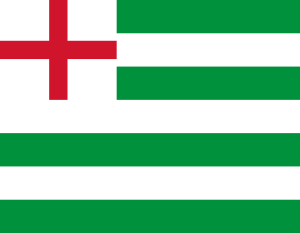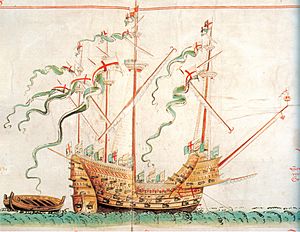Tudor navy facts for kids
The Tudor navy was the navy of England when the Tudor dynasty ruled (from 1485 to 1603). This time was very important for the navy. It led to England having a permanent navy and set up the base for the future Royal Navy.
Contents
Henry VII's Role in Sea Power
Henry VII (ruled 1485–1509) believed in strong sea power. He supported an old law that said goods should only be moved on English ships. This helped England's navy grow.
Henry started building bigger merchant ships than before. He also put money into dockyards, which are places where ships are built and repaired. In 1495, he built the oldest surviving dry dock in Portsmouth. The ships Sweepstake and Mary Fortune were among the first built there.
He inherited some ships and bought others. He also built new ones like the Regent and the Sovereign.
Henry VIII (ruled 1509–1547) is often called the "Father of the English Navy." He started with only seven small warships from his father. By 1514, he had added two dozen more. He even bought warships from other countries.
In 1513, his fleet, led by Sir Edmund Howard, sailed down the River Thames. It was the strongest English navy ever seen, with 24 ships. The biggest was the 1600-ton "Henry Imperial." This fleet had 5000 soldiers and 3000 sailors. It pushed the French fleet back and took control of the English Channel.
Henry was the first king to make the navy a permanent force. It had its own structure and was paid for by taxes. He created the new Navy Board to manage it. He also set up royal dockyards and planted trees for shipbuilding. He even made laws for river travel and built forts along the coast. He was very involved in designing his warships and their guns. He loved watching new ships being launched.
In 1514, the 1,500-ton Henry Grace à Dieu was launched. It was the first English ship with two decks. It was also one of the first warships with gunports and heavy bronze cannons. Henry also ordered the Anthony Roll, a detailed record of his navy around 1546. This book gives us many pictures of his ships.
Henry VIII also started making cannons in England. Later, English workers learned to make cheaper cast iron cannons. This made it easier for England to arm its navy.
After a war with France, Henry decided to keep 30 ships active even in peacetime. This meant setting up shore bases and hiring more people to manage the navy. By 1540, the navy had 45 ships. In 1545, the Mary Rose sank during a battle with the French. That same year, a special council was formed to manage the navy. When there was no war, the navy mostly chased pirates.
Historians say Henry built up the navy's organization. It helped defend England and made the country look stronger to others.
Edward and Mary's Time
Edward VI and Mary I (ruled after Henry VIII) did not add much new to the navy. Mary kept up the shipbuilding. The navy did okay in a war with France from 1557 to 1559, but it couldn't stop England from losing Calais.
Mary's marriage to Philip II led to trade with Spain. This allowed English shipbuilders to learn from Spanish ship designs. Spanish warships visited English ports, helping England improve its own ships. This learning was very important for the future growth of the English Navy.
Elizabeth I and the Spanish Armada
When Elizabeth I became queen in 1559, the navy had 39 ships. She made naval strength a top priority. She supported sailors like John Hawkins and Francis Drake. These "Sea Dogs" attacked Spanish merchant ships carrying gold and silver from the New World. This risked war with Spain.
Elizabeth kept spending money on the navy for 20 years. She made sure new ships were built steadily.
By the 1580s, tensions with Spain were very high. Drake's raid on Cadiz in 1587 destroyed many Spanish ships. In 1588, Philip II of Spain sent the Spanish Armada to invade England. But after a long battle, the Armada was scattered and went home. These famous battles were part of the long war between England and Spain.
The Tudor Navy was one of the first permanent navies. Before this, merchant ships were often used as warships only during wars. These ships would have temporary wooden castles added for soldiers to fire from.
Naval warfare at this time often helped armies on land, like moving troops. Before cannons were widely used, warships tried to crash into each other so soldiers could board the enemy ship. But with cannons, ships could stay further away and fire powerful shots to sink enemy vessels. Sailors used daggers, swords, pikes, and early handguns. The use of gunpowder helped navies become a constant part of maritime states.
Large, cannon-equipped warships also showed off royal power. Ships like Henry VIII's Mary Rose were symbols of the king's strength.
In the 1500s, naval guns improved a lot. Henry VII used more guns on his ships. Henry VIII introduced gunports into ship designs. This moved guns from high on the deck to lower down in the ship. This made ships more stable and allowed them to fire all their guns from one side at once (a "broadside").
The navy yards were leaders in new ideas. Captains also created new ways to fight. The full-rigged ship was a huge step forward in naval warfare. In 1573, English shipbuilders made designs that allowed ships to sail faster and turn better. These ships could also carry heavier guns.
When Spain tried to invade England, the English warships, designed by Hawkins and Drake, were longer, faster, and had more guns than the Spanish ones. The better English ships and sailing skills stopped the invasion and led to the defeat of the Spanish Armada in 1588. This was a high point for Elizabeth's reign. The Spanish cannons were slower to reload, which gave the English an advantage in close battles.
Important Leaders (1485-1546)
- Admiral of England, Ireland and Aquitaine: This was the top naval commander.
- John de Vere, 13th Earl of Oxford, 1485-1512
- Sir Edward Howard, 1512-1513
- Thomas Howard, 3rd Duke of Norfolk, 1513-1525
- Clerk of Marine Causes: Managed navy records and supplies.
- Clerk Comptroller of the Navy: Checked navy accounts.
- Keeper of the Storehouses: Looked after navy supplies.
Important Leaders (1546-1603)
- Lord High Admirals of England:
- Thomas Seymour, 1546-1549
- John Dudley, 1549-1550
- Edward Clinton, 1550-1554
- William Howard, 1554-1558
- Edward Clinton, 1st Earl of Lincoln, 1558-1585
- Charles Howard, 1st Earl of Nottingham, 1585-1603
In 1546, Henry VIII created the Council of the Marine to manage the navy's daily business.
- Lieutenants of the Admiralty: Assisted the Lord High Admiral.
- Treasurers of Marine Causes: Managed the navy's money.
- Sir John Hawkins was a Treasurer from 1577-1595.
- Surveyors and Riggers of the Navy: Oversaw ship construction and rigging.
- Masters of Naval Ordnance: Managed the navy's weapons and cannons.
- Comptrollers of the Navy: Checked spending and supplies.
- Surveyors of Marine Victuals: Made sure ships had enough food and drink.
- Clerk of the Navy (also called Clerk of the Ships): Kept records for the navy.
What Lasted from This Time?
The Tudor period was very important for the navy. However, after 1601, the navy's efficiency slowly went down. There was more corruption until things were fixed by an investigation in 1618.
See also



